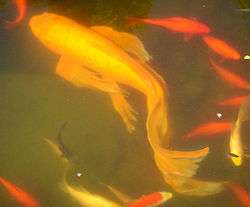Butterfly koi
Butterfly koi, longfin koi, or dragon carp are a type of ornamental fish notable for their elongated finnage. The fish are a breed of the common carp, Cyprinus carpio, which includes numerous wild carp races as well as domesticated koi ("Nishikigoi").

Butterfly koi originated in the mid-20th century as a result of an effort to increase the hardiness of traditional koi. Japanese breeders interbred wild Indonesian longfin river carp with traditional koi. The resulting fish had longer fins, long barbells, pompom nostrils, and were hardier than koi. These were known in Japan as "onagaoi" or "hire naga goi", or translated in English "long tail carp". Randy LeFever, the son of Wyatt LeFever, a noted breeder of koi, is credited with suggesting they looked like butterflies, a trait for which the breed is named. They are also sometimes referred to as Dragon Koi.
For clarification, the word koi is wholly inaccurate for describing these fish; Koi are, as dictated by the Japanese breeders, Nishikigoi, these long-finned carp are Hirenagagoi. The word koi has been given to these fish to increase their resale value and popularity in garden centres and the like.
Nishikigoi judging
Butterfly koi cannot be judged using the traditional criteria used for koi judging. The standard criteria used in these events has evolved over many years, and they are specifically tailored to rate the characteristics of koi. According to an article in KOI USA magazine, the following characteristics are largely the basis for the unsuitability of butterfly koi in traditional competition:
Conformation – The ideal shape of a koi has been set by tradition to be generously oval. By contrast, butterfly koi are naturally more slender. This difference is amplified by the fact that traditional koi judging is done from a top-down viewing angle.
Relationship of fin to body – The ratio of fin-to-body is an important scoring criteria in nishikigoi competitions. By design, longfin embody a ratio that exceeds the standards applied to nishikigoi by 500 to 1000 percent.
Pattern differences - Great energy has been given to developing butterfly koi versions of traditional koi patterns, (e.g. kohaku, sanke, showa, utsuri and ogon). Butterfly koi, however, exhibit these patterns in a slightly different way.
For these reasons, Japan's Zen Nippon Airinkai ZNA (an organization that sanctions Japanese nishikigoi hobbyist competitions) have disallowed butterfly koi from competitive judging for many years; the UK Koi Judges Association also excludes these fish from competition although their American counterpart the Associated Koi Clubs of America (AKCA) has (as of June 2006) reportedly created new standards for judging butterfly koi at future AKCA competitions. American shows that permit longfin or butterfly koi usually enter them as a variety. These entrants rarely win higher awards, however some shows feature "Best Longfin" under and over 18 inches.
Popularity
Butterfly carp are preferred by many keepers of traditional koi who view the breed as superior to normal koi, although all koi are the result of continuous inbreeding whenever a new recessive gene showed itself over the centuries. The preference for butterfly koi by some traditional keepers may be the reason why most reputable koi retailers often sell butterfly koi, and why most of Japan's famous and prestigious breeders breed them today. Moreover, they are largely popular in Europe and Asia, and are popular with new hobbyists and in North America, where they are readily available. They can be in pet, pond, and fish keeping supply stores or preferably, specialized koi breeders. The popularity of these fish in North America has earned them the nickname, "American koi". Hence, the butterfly koi is growing in popularity worldwide.
Examples of Butterfly Koi are becoming more widely available as demand grows, seeing many variations in color and quality emerge.
The Butterfly has very similar feeding requirements and habits to other Koi and so can be kept alongside them happily.